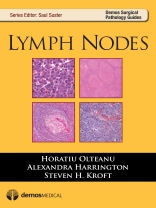The Demos Surgical Pathology Guides series presents in summary and visual form the basic knowledge base that every practicing pathologist needs every working day. Series volumes cover the major specialty areas of surgical pathology, and coverage emphasizes the key entities and diagnoses that pathologists will see in practice, and that they must know whether in training or practice. The emphasis is on the basic morphology with newer techniques represented where they are frequently used. The series provides a handy summary and quick reference that any pathology resident or fellow will find useful. Experienced practitioners will find the series valuable as a portable ‘refresher course’ or review tool.
Lymph Nodes presents the full gamut of lymph node disorders and diagnoses that pathologists commonly see in practice. Traditional morphology and histopathologic features, coupled with clinical data, are emphasized. Chapters are complemented with both high-power images for analysis of cytologic features of lymph node cells as well as low-power images for assessment of lymph node architecture.
The chapters cover infectious lymphadenopathies, reactive lymphadenopathies, lymphadenopathies associated with systemic disorders, lymph node inclusions, spindle cell neoplasms of lymph nodes, foreign body lymphadenopathies, mature B-cell neoplasms, precursor lymphoid neoplasms, Hodgkin lymphoma, and more. Lymph Nodes is highly illustrated throughout and provides residents and clinicians with a quick reference for rotation or review.
Inhoudsopgave
Series Foreword; The Normal Lymph Node;
Infectious Lymphadenopathies : Infectious Mononucleosis Lymphadenitis; Cytomegalovirus Lymphadenitis; Herpes Simplex Virus Lymphadenitis; Human Immunodeficiency Virus Lymphadenitis; Nonspecific Bacterial Lymphadenitis; Cat Scratch Lymphadenitis; Bacillary Angiomatosis; Syphilis (Luetic) Lymphadenitis;
Mycobacterium Tuberculosis Lymphadenitis; Mycobacterium Avium-Intracellulare Lymphadenitis; Histoplasma Lymphadenitis; Coccidioides Lymphadenitis; Filariasis; Reactive Lymphadenopathies : Follicular Hyperplasia; Paracortical Hyperplasia; Sinus Histiocytosis; Progressive Transformation of Germinal Centers (PTGC); Dermatopathic Lymphadenopathy; Lymphadenopathies Associated With Systemic Disorders : Kimura Lymphadenopathy; Sinus Histiocytosis with Massive Lymphadenopathy (Rosai-Dorfman Disease); Kikuchi-Fujimoto Lymphadenopathy; Sarcoidosis; Systemic Lupus Erythematosus Lymphadenopathy; Rheumatoid Lymphadenopathy; Castleman Disease; Hyaline Vascular Castleman Disease; Unicentric Castleman Disease, Plasma Cell Variant; Multicentric Castleman Disease; Still’s Disease; Ig G4-Related Sclerosing Disease; Autoimmune Lymphoproliferative Syndrome; Lymph Node Inclusions : Epithelial Cell Inclusions in Lymph Nodes; Nevus Cell Inclusions in Lymph Nodes; Spindle Cell Neoplasms of Lymph Nodes : Palisaded Myofibroblastoma; Inflammatory Pseudotumor of Lymph Node; Vascular Lymphadenopathies and Neoplasms of Lymph Nodes : Vascular Transformation of Lymph Node Sinuses; Angiomymatous Hamartoma; Hemangiomas and Hemangioendotheliomas; Kaposi Sarcoma; Metastatic Tumors in Lymph Nodes; Foreign Body Lymphadenopathies : Metal Debris-Associated Lymphadenopathy; Lymphangiography-Associated Lymphadenopathy; Mature B-Cell Neoplasms : Nomenclature and Classification; Chronic Lymphocytic Leukemia/Small Lymphocytic Lymphoma (CLL/SLL); Splenic B-Cell Marginal Zone Lymphoma (SMZL); Hairy Cell Leukemia (HCL); Lymphoplasmacytic Lymphoma (LPL); Heavy Chain Diseases (HCDs); Extraosseous Plasmacytoma; Nodal Marginal Zone Lymphoma (MZL); Follicular Lymphoma (FL); Mantle Cell Lymphoma (MCL); Diffuse Large B-Cell Lymphoma, Not Otherwise Specified (DLBCL, NOS); DLBCL Subtypes; Primary Mediastinal Large B-Cell Lymphoma (PMLBCL); ALK Positive Large B-Cell Lymphoma; Plasmablastic Lymphoma (PBL); Large B-Cell Lymphoma Arising in HHV8-Associated Multicentric Castleman Disease; Burkitt Lymphoma (BL); B-Cell Lymphoma, Unclassifiable, with Features Intermediate Between Diffuse Large B-Cell Lymphoma and Burkitt Lymphoma; B-Cell Lymphoma, Unclassifiable, with Features Intermediate Between Diffuse Large B-Cell Lymphoma and Classical Hodgkin Lymphoma; Mature T- and NK-Cell Neoplasms : T-Cell Prolymphocytic Leukemia; Aggressive NK-Cell Leukemia/Lymphoma; Adult T-Cell Leukemia/Lymphoma; Sezary Syndrome/Mycosis Fungoides; Peripheral T-Cell Lymphoma, Not Otherwise Specified; Angioimmunoblastic T-Cell Lymphoma; Anaplastic Large Cell Lymphoma, ALK Positive; Anaplastic Large Cell Lymphoma, ALK Negative; Hodgkin Lymphoma : Nodular Lymphocyte Predominant Hodgkin Lymphoma; Nodular Sclerosis Classical Hodgkin Lymphoma; Mixed Cellularity Classical Hodgkin; Lymphocyte Rich Classical Hodgkin Lymphoma; Lymphocyte-Depleted Classical Hodgkin Lymphoma; Immunodeficiency-Associated Lymphoproliferative Disorders : Lymphomas Associated with HIV Infection; Post-Transplant Lymphoproliferative Disorders (PTLD); Early Lesions: Plasmacytic Hyperplasia and Infectious Mononucleosis (IM)-Like PTLD; Polymorphic PTLD; Monomorphic PTLD; Classical Hodgkin Lymphoma Type PTLD; Other Iatrogenic Immunodeficiency-Associated Lymphoproliferative Disorders; Histiocytic and Dendritic Cell Neoplasms : Histiocytic Sarcoma; Langerhans Cells Histiocytosis; Langerhans Cell Sarcoma; Interdigitating Dendritic Cell Sarcoma; Follicular Dendritic Cell Sarcoma; Precursor Lymphoid Neoplasms : Lymphoblastic Leukemia/Lymphoma; Acute Myeloid Leukemia and Related Precursor Neoplasms : Myeloid Sarcoma; Blastic Plasmacytoid Dendritic Cell Neoplasm; References
Over de auteur
Saul Suster, MD, Professor and Chairman, Department of Pathology, Medical College of Wisconsin












